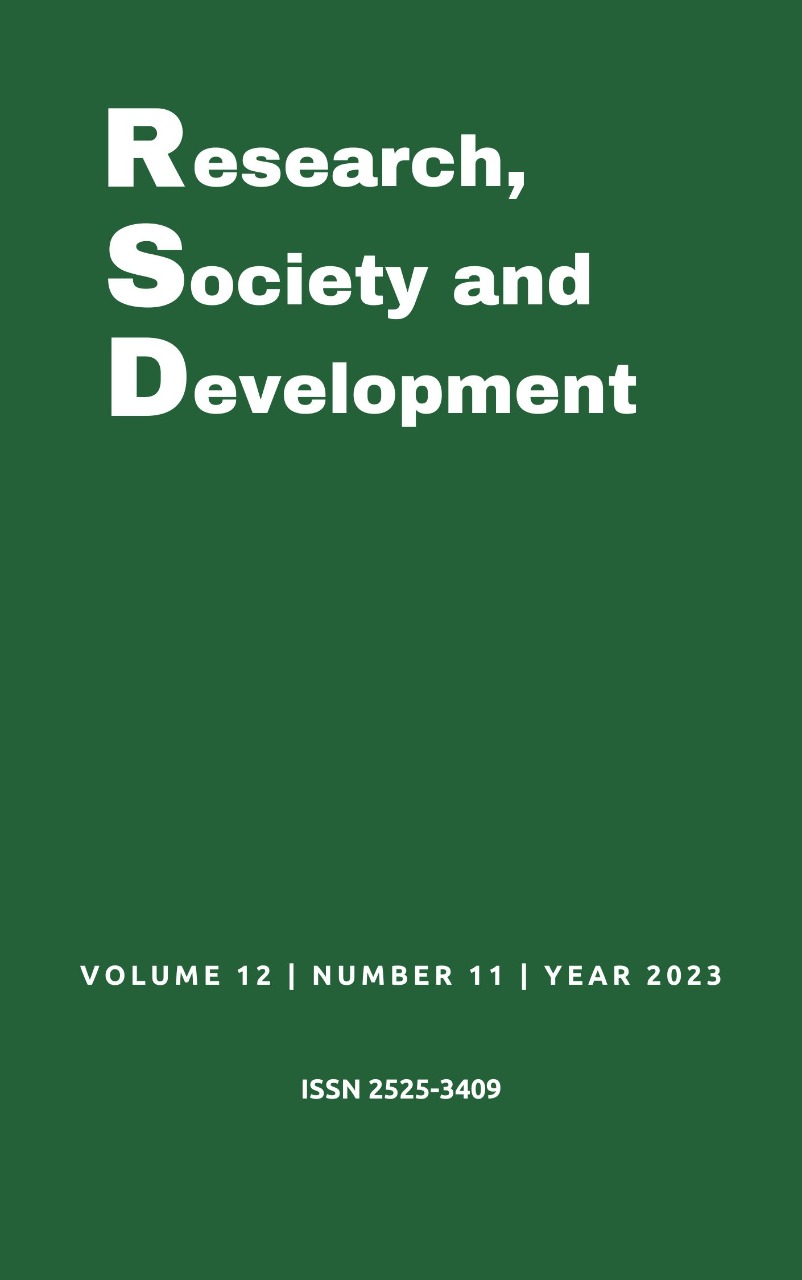COVID-19 e ácido hialurônico na harmonização orofacial
DOI:
https://doi.org/10.33448/rsd-v12i11.43888Palavras-chave:
Vacinas contra COVID-19; Ácido hialurônico; Face.Resumo
Desde o surgimento da COVID-19 em Wuhan, a pandemia se espalhou pelo mundo, causando muitas mortes e afetando milhões de pessoas. Enquanto isso, o ácido hialurônico tem sido utilizado na harmonização orofacial para preencher rugas e sulcos na pele. No entanto, a aplicação de preenchedores dérmicos, como o ácido hialurônico, pode levar a uma complicação rara chamada edema tardio intermitente e persistente (ETIP), que causa inchaço e vermelhidão na área tratada. A relação entre a ETIP, a vacinação da COVID-19 e a harmonização orofacial tem sido estudada por especialistas que sugerem que a ETIP pode ser decorrente e iniciada após a aplicação da vacina. É importante que os profissionais de saúde estejam cientes dessa possível relação e informem seus pacientes sobre os riscos antes de realizar qualquer procedimento estético. Dessa forma, essa revisão narrativa da literatura tem como objetivo ofertar um documento catalogado sobre a relação entre ETIP, COVID-19 e ácido hialurônico como preenchedor dérmico na prática clínica da harmonização orofacial.
Referências
Abatangelo, G., Vindigni, V., Avruscio, G., Pandis, L., & Brun, P. (2020). Hyaluronic Acid: Redefining Its Role. Cells, 9(7), 1743.
Chams, N., Chams, S., Badran, R., Shams, A., Araji, A., Raad, M., Mukhopadhyay, S., Stroberg, E., Duval, E. J., Barton, L. M., & Hajj Hussein, I. (2020). COVID-19: A Multidisciplinary Review. Frontiers in Public Health, 8, 383.
Chung, K. L., Convery, C., Ejikeme, I., & Ghanem, A. M. (2020). A Systematic Review of the Literature of Delayed Inflammatory Reactions After Hyaluronic Acid Filler Injection to Estimate the Incidence of Delayed Type Hypersensitivity Reaction. Aesthetic surgery journal, 40(5), NP286–NP300.
Fernandes, Q., Inchakalody, V. P., Merhi, M., Mestiri, S., Taib, N., Moustafa Abo El-Ella, D., Bedhiafi, T., Raza, A., Al-Zaidan, L., Mohsen, M. O., Yousuf Al-Nesf, M. A., Hssain, A. A., Yassine, H. M., Bachmann, M. F., Uddin, S., & Dermime, S. (2022). Emerging COVID-19 variants and their impact on SARS-CoV-2 diagnosis, therapeutics and vaccines. Annals of medicine, 54(1), 524–540.
Funt D. K. (2022). Treatment of Delayed-onset Inflammatory Reactions to Hyaluronic Acid Filler: An Algorithmic Approach. Plastic and reconstructive surgery. Global open, 10(6), e4362.
Graça, M. F. P., Miguel, S. P., Cabral, C. S. D., & Correia, I. J. (2020). Hyaluronic acid-Based wound dressings: A review. Carbohydrate polymers, 241, 116364.
Habas, K., Nganwuchu, C., Shahzad, F., Gopalan, R., Haque, M., Rahman, S., Majumder, A. A., & Nasim, T. (2020). Resolution of coronavirus disease 2019 (COVID-19). Expert review of anti-infective therapy, 18(12), 1201–1211.
Jesus, A. A. de, Suguihara, R. T., & Muknicka, D. P. (2023). COVID-19 and dermal fillers in orofacial harmonization. Research, Society and Development, 12(7), e1612742395.
Juncan, A. M., Moisă, D. G., Santini, A., Morgovan, C., Rus, L. L., Vonica-Țincu, A. L., & Loghin, F. (2021). Advantages of Hyaluronic Acid and Its Combination with Other Bioactive Ingredients in Cosmeceuticals. Molecules (Basel, Switzerland), 26(15), 4429.
Li, A., Fang, R., & Sun, Q. (2022). Delayed inflammatory reactions to hyaluronic acid filler injection: Should be treated but should not be overtreated. Journal of cosmetic dermatology, 21(8), 3625–3626.
Lopes, N. V., Suguihara, R. T., & Muknicka, D. P. (2023). The relationship between hyaluronic acid and COVID-19: a narrative review of the literature. Research, Society and Development, 12(8), e2612842869.
López Pérez V. (2022). COVID-19 and Dermal Fillers: Should We Really Be Concerned?. COVID y rellenos faciales ¿realmente debemos preocuparnos?. Actas dermo-sifiliograficas, 113(9), 888–894.
Majumder, J., & Minko, T. (2021). Recent Developments on Therapeutic and Diagnostic Approaches for COVID-19. The AAPS journal, 23(1), 14.
Munavalli, G. G., Guthridge, R., Knutsen-Larson, S., Brodsky, A., Matthew, E., & Landau, M. (2022). COVID-19/SARS-CoV-2 virus spike protein-related delayed inflammatory reaction to hyaluronic acid dermal fillers: a challenging clinical conundrum in diagnosis and treatment. Archives of Dermatological Research, 314(1), 1-15.
Murray, G., Convery, C., Walker, L., & Davies, E. (2021). Guideline for the Safe Use of Hyaluronidase in Aesthetic Medicine, Including Modified High-dose Protocol. The Journal of clinical and aesthetic dermatology, 14(8), E69–E75.
Ochani, R., Asad, A., Yasmin, F., Shaikh, S., Khalid, H., Batra, S., Sohail, M. R., Mahmood, S. F., Ochani, R., Hussham Arshad, M., Kumar, A., & Surani, S. (2021). COVID-19 pandemic: from origins to outcomes. A comprehensive review of viral pathogenesis, clinical manifestations, diagnostic evaluation, and management. Le infezioni in medicina, 29(1), 20–36.
Rother, E. T. (2007). Revisão sistemática x revisão narrativa. Acta Paul. Enferm, 20(2).
Saboia, T. P. S., Cabral, M. R. L., & Neres, L. L. F. G. (2021). The use of hyaluronic acid in facial matching. Research, Society and Development, 10(14), e94101421731.
Safran, T., Swift, A., Cotofana, S., & Nikolis, A. (2021). Evaluating safety in hyaluronic acid lip injections. Expert opinion on drug safety, 20(12), 1473–1486.
Snozzi, P., & van Loghem, J. (2022). Treatment of Delayed-onset Inflammatory Reactions to Hyaluronic Acid Filler: An Update. Plastic and reconstructive surgery. Global open, 10(10), e4570.
Downloads
Publicado
Como Citar
Edição
Seção
Licença
Copyright (c) 2023 Viviane Hernandes; Roberto Teruo Suguihara; Daniella Pilon Muknicka

Este trabalho está licenciado sob uma licença Creative Commons Attribution 4.0 International License.
Autores que publicam nesta revista concordam com os seguintes termos:
1) Autores mantém os direitos autorais e concedem à revista o direito de primeira publicação, com o trabalho simultaneamente licenciado sob a Licença Creative Commons Attribution que permite o compartilhamento do trabalho com reconhecimento da autoria e publicação inicial nesta revista.
2) Autores têm autorização para assumir contratos adicionais separadamente, para distribuição não-exclusiva da versão do trabalho publicada nesta revista (ex.: publicar em repositório institucional ou como capítulo de livro), com reconhecimento de autoria e publicação inicial nesta revista.
3) Autores têm permissão e são estimulados a publicar e distribuir seu trabalho online (ex.: em repositórios institucionais ou na sua página pessoal) a qualquer ponto antes ou durante o processo editorial, já que isso pode gerar alterações produtivas, bem como aumentar o impacto e a citação do trabalho publicado.

